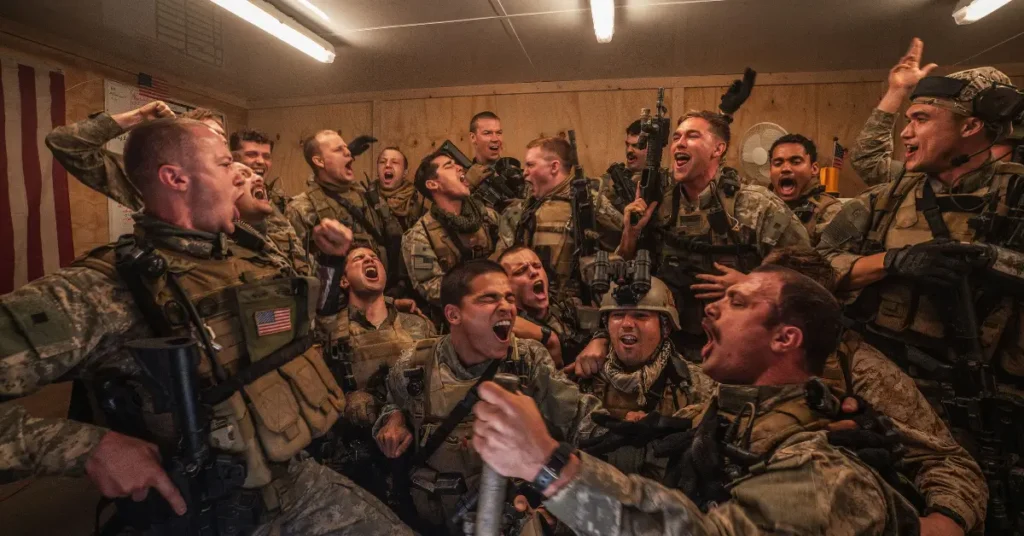Warfare 2025: A Visceral Examination of Combat and Mental Health
In the landscape of war films, Warfare 2025, emerges as a groundbreaking new movie that transcends typical military narratives by offering an unflinching exploration of combat’s psychological impact. Co-directed by retired Navy SEAL Ray Mendoza and acclaimed filmmaker Alex Garland, this gripping war drama delves deep into the mental health realities faced by soldiers in high-stress combat situations, offering viewers rare insight into the psychological costs of modern warfare.
Thank you for reading this post, don't forget to subscribe!Basic Film Information
Title: Warfare
Release Date: April 11, 2025
Director: Ray Mendoza and Alex Garland
Screenwriter: Based on Ray Mendoza’s real-life experiences
Main Cast:
- D’Pharaoh Woon-A-Tai
- Will Poulter
- Cosmo Jarvis
- Kit Connor
- Joseph Quinn
- Charles Melton
- Noah Centineo
Genre: War Drama
Runtime & Rating: 135 minutes, R (for intense combat sequences, graphic violence, and language)

Plot Summary: Unvarnished Reality
Warfare chronicles a harrowing 2006 surveillance mission in Ramadi, Iraq, that rapidly deteriorates when a Navy SEAL platoon becomes trapped during an ambush by insurgent forces. Unlike many war films that romanticize combat or focus primarily on heroic acts, Warfare presents the raw, chaotic reality of modern urban warfare and its immediate psychological impacts.
The narrative unfolds in near real-time, allowing viewers to experience the mounting tension, split-second decisions, and psychological strain that the soldiers endure. By focusing on a single mission gone wrong, the film creates an intimate psychological portrait of combat stress in its acute phase.
Setting & Cinematic Techniques
The film’s approach to cinematography directly serves its mental health themes. Shot chronologically with extended takes, the camera becomes an embedded observer, creating an immersive experience that communicates the disorientation and anxiety of combat situations.
The production team constructed an elaborate set replicating Ramadi in a London suburb, with meticulous attention to environmental details. This authenticity extends to the sound design, which deliberately avoids dramatic musical cues during combat sequences, instead emphasizing the disorienting cacophony of gunfire, radio chatter, and labored breathing all elements that contribute to the psychological pressure depicted on screen.
Particularly effective is the film’s use of subjective camera techniques during moments of acute stress, visually representing how perception narrows under threat a phenomenon known as “tunnel vision” that occurs during extreme stress responses.
Mental Health Representation: Strengths & Weaknesses
Psychological Accuracy
Warfare stands apart in its portrayal of the immediate psychological impacts of combat. Rather than focusing exclusively on post-traumatic stress disorder (PTSD) as many war films do, it captures the spectrum of real-time psychological responses to combat:
- Acute stress reactions: Characters display varying responses including hypervigilance, emotional numbing, and dissociative symptoms during and immediately following intense combat
- Decision fatigue: The film illustrates how prolonged stress impairs cognitive function and decision-making
- Moral injury: Several pivotal scenes address the psychological damage that occurs when soldiers witness or participate in actions that violate their moral code
- Varied coping mechanisms: Different characters employ distinct strategies to manage stress, from dark humor to compartmentalization
Consulting psychologists who specialize in military mental health reportedly worked with the production, ensuring that these portrayals avoided sensationalism while maintaining dramatic impact.
Authenticity vs. Accessibility
The film’s greatest strength may also present its biggest challenge for general audiences its unflinching realism. For viewers without military experience, some of the psychological nuances might be missed without additional context. However, this commitment to authenticity ultimately serves the film’s purpose of educating civilians about military mental health challenges.
A particularly effective sequence shows a character experiencing momentary dissociation during an intense firefight a realistic depiction of peritraumatic dissociation that occurs in approximately 30% of individuals during traumatic events. Rather than dramatizing this as a cinematic breakdown, the film portrays it as a subtle but dangerous lapse in situational awareness exactly as it might manifest in a real combat situation.
The Personal Element: Mendoza’s Experience
What distinguishes Warfare from other war films is co-director Ray Mendoza’s direct involvement. Having been awarded the Silver Star for his actions during the actual mission portrayed in the film, Mendoza brings unparalleled authenticity to the production. In pre-release interviews, Mendoza has spoken openly about how creating the film served as a form of exposure therapy, allowing him to process his own combat experiences.
This therapeutic aspect of the filmmaking process itself adds a meta-layer to the movie’s mental health narrative. The production became a vehicle for veterans involved in the project to communicate their experiences to a broader audience, potentially reducing the isolation many feel upon returning to civilian life.
Critical Reception & Impact
Critics have largely praised Warfare for its psychological depth. Matt Zoller Seitz of RogerEbert.com described it as a “brutal, uncompromising procedural” that offers a visceral look into the realities of combat. Mental health professionals who have previewed the film have noted its value as a potential educational tool for civilian clinicians working with military populations.
The film avoids both glorification of violence and exploitation of trauma. Instead, it presents a nuanced examination of how humans function under extreme duress, highlighting both resilience and vulnerability. By focusing on the immediate psychological impacts rather than just the long-term consequences, Warfare fills an important gap in media portrayals of combat psychology.
Cultural Context: Changing Perceptions of Military Mental Health
Warfare arrives at a pivotal moment in public discourse around military mental health. Following decades of operations in Iraq and Afghanistan, there’s growing recognition of the psychological costs of deployment. The film contributes meaningfully to this conversation by:
- Normalizing the wide range of psychological responses to combat stress
- Illustrating that mental health impacts occur during deployment, not just afterward
- Showing that psychological responses to combat are normal human reactions rather than weaknesses
- Depicting the complex interplay between unit cohesion and individual psychological resilience
The film also addresses how military culture itself can both support mental health (through camaraderie and purpose) and hinder it (through stigma around expressing vulnerability).
The Actor’s Commitment: Embodying the Experience
The film’s cast underwent intensive military training to prepare for their roles, experiencing a fraction of the physical and mental demands placed on actual service members. This preparation extended beyond physical conditioning to include education about combat psychology and stress responses.
In interviews, several cast members have spoken about how this immersive preparation gave them newfound respect for the psychological resilience required in military service. Will Poulter noted that even in a controlled training environment, the physical and mental exhaustion began affecting his thought processes and emotional regulation providing insight into the psychological challenges faced by those in actual combat situations.
Final Assessment: A Landmark in Mental Health Representation
Warfare represents a significant evolution in how combat psychology is portrayed on screen. By prioritizing authenticity over spectacle and psychological reality over dramatic convention, the film serves as both compelling cinema and valuable cultural document.
For viewers seeking to understand the mental health challenges faced by military personnel, Warfare offers unprecedented insight. The film’s commitment to depicting the full spectrum of psychological responses to combat from functional stress responses to potentially traumatic experiences helps bridge the civilian-military divide in understanding combat psychology.
Most importantly, by showing both vulnerability and strength in its characters, Warfare contributes to destigmatizing mental health challenges in military contexts. It presents psychological responses to combat as natural human reactions rather than weaknesses, potentially encouraging service members to recognize and address their own mental health needs.
Warfare will be available in theaters beginning April 11, 2025, with digital release following on May 6, 2025. For veterans who may find the content triggering, support resources are available through the Veterans Crisis Line at 988 (press 1) or via text at 838255.
Have you watched films that accurately portray the mental health aspects of military service? Share your thoughts in the comments below.

